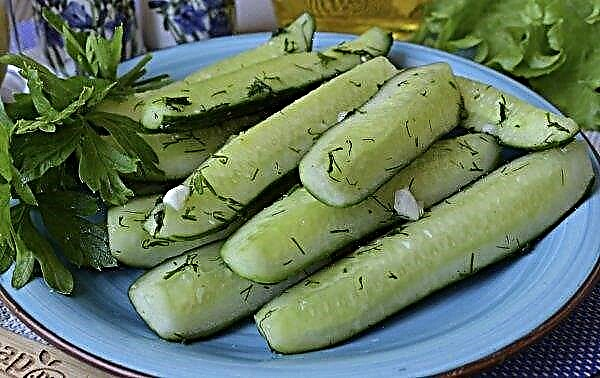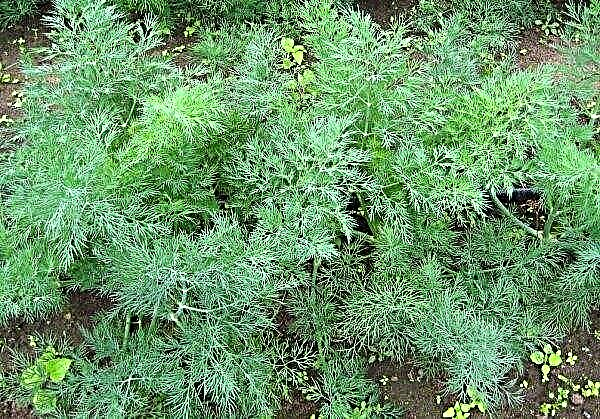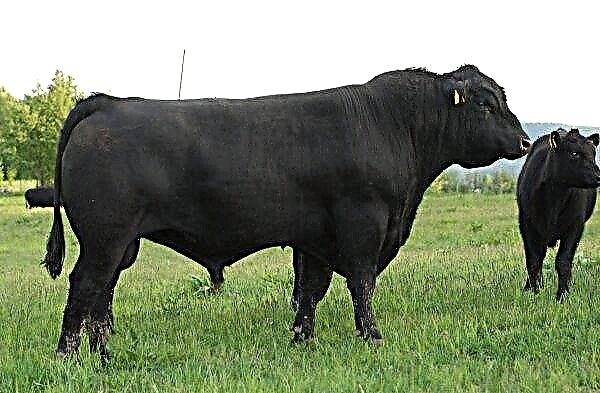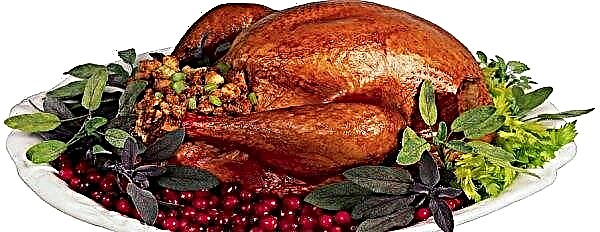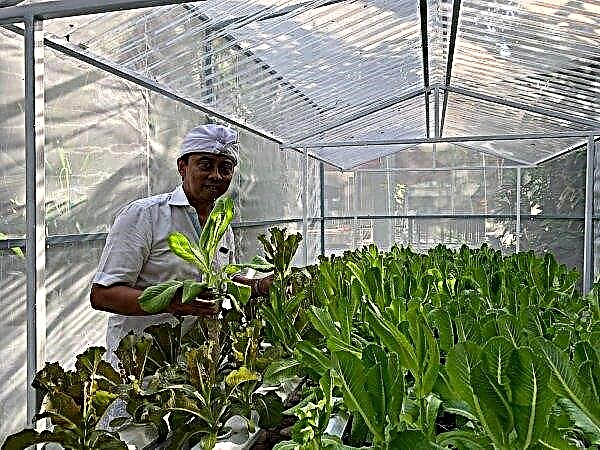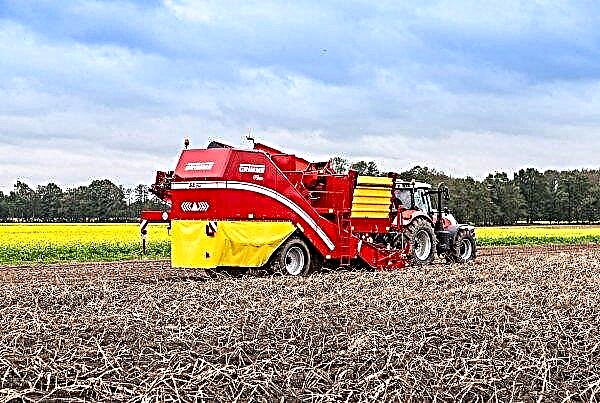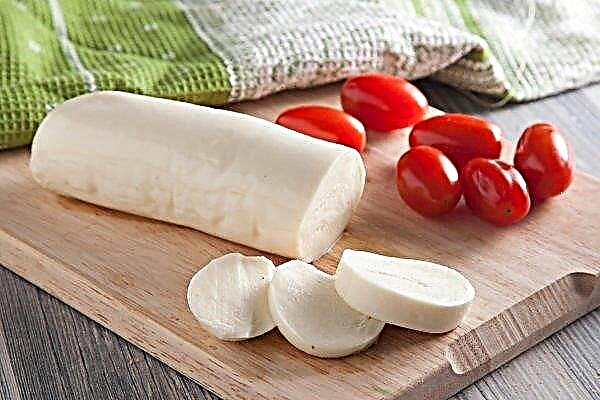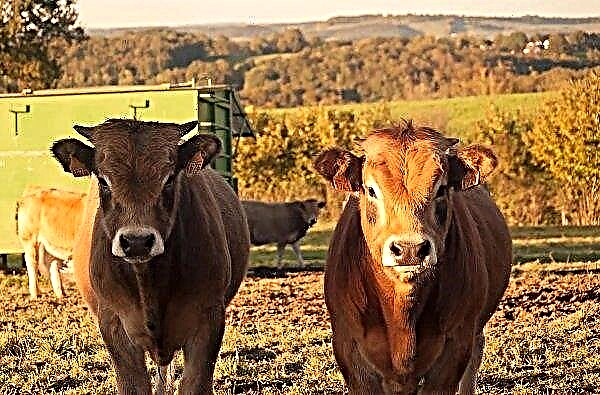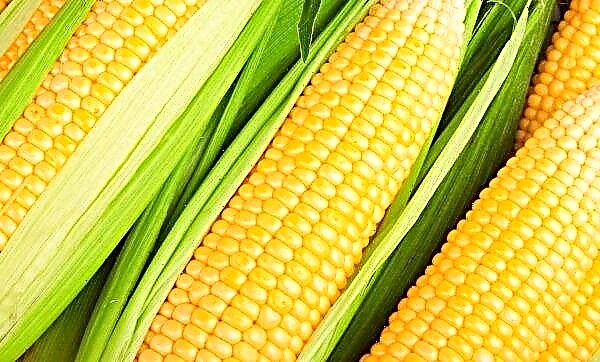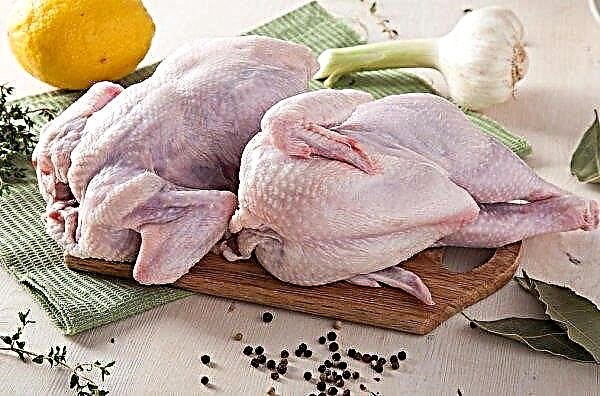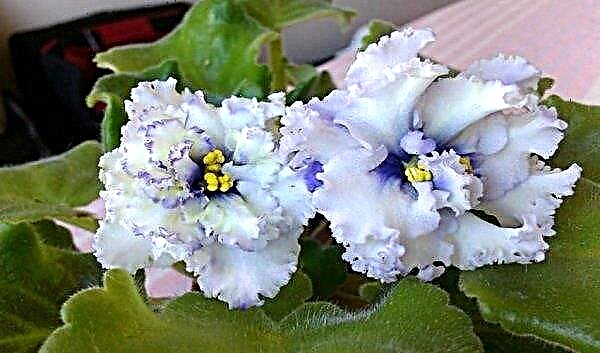Helios grapes (another name is pink Arcadia) attracts agrarians with a musky aftertaste and high yield. However, in order to get quality fruits, you need to know about the biological characteristics of the variety and create the right conditions for growing. Read about it below.
The history of the breeding of Helios grapes
The variety is the result of amateur selection. Varieties of raisins Nakhodka and Arcadia were used as parent plants. The author of the hybrid is V.N. Krainov.
Did you know? Previously, grape pickers wrote a will before leaving for a shift. The fact is that the supports for the vine were trees that died over time, therefore, climbing on it, the man risked falling down along with the tree.
Grade description
The Helios grape variety is a tall, highly branched hybrid characterized by early ripening - the fruits reach physical maturity 110–120 days after the appearance of the buds.
Other grade features:
- the trunk and vine are brown; young shoots are lighter in shade;
- bulky dark green leaves have a rounded shape;
- bisexual flowers provide the possibility of self-pollination, as well as the use of varieties as a pollinator for similar crops with the same flowering period;
- the variety is medium resistant to frost, can withstand cold up to –23 ° C;
- the variety has a pronounced resistance to mildew, oidium and various types of rot that cause fungal spores.
Advantages and disadvantages of the variety
Helios grapes have varietal advantages and disadvantages, namely:
- Pros:
- high palatability of fruits, allowing them to be used in different areas of cooking and winemaking;
- consistently high productivity;
- lack of tendency to chop berries and crack the skin;
- resistance to diseases characteristic of grape crops.
- Minuses:
- whimsical care;
- medium frost resistance - the variety needs winter shelter.
Characteristics of the Helios variety
The Helios grape variety is distinguished by high quality and quantity indicators of the crop, which helped it to gain success among farmers.
Did you know? The most nutritious and vitamin-rich part of the grape fruit is the skin. It contains a large number of antioxidants and hard fibers, which help cleanse the intestines of toxins.
Bunches and fruits
After pollination, shoots form cylindrical-conical clusters with berries. Pink fruits are oval. Thick, crispy skin reliably protects the sugary juicy-watery pulp. Each berry contains 2-3 seeds and weighs an average of 16 g. The main feature of the fruits of this variety is the same size (3.5 × 2 cm). They are not prone to chopping even in the driest years and with a strong thickening of the crown.
Fruits are sweet, with a long nutmeg aftertaste. The skin does not affect the taste. The fruits retain their presentation for a long time and tolerate transportation well. Used in winemaking, for raw consumption and for the preparation of various culinary delights in the form of desserts, sauces.
Video: Helios grapes
Productivity
Each bush can be removed annually 6-8 kg of fruit. The weight of the bunch varies from 500 to 900 g. When creating ideal conditions for care, the weight of the bunch can reach 1.5 kg.
Features of planting and growing Helios grapes
The variety is whimsical to the quality of the soil and the conditions of care. To the slightest deviation in care reacts with a decrease in yield.
Landing rules
Helios is planted in the spring. So the plants better take root in the new soil and enter the fruiting phase faster. The variety grows rapidly and branches strongly, so it will require a vast area for planting. Better "Helios" bears fruit in open sunny areas, protected from draft, with a low occurrence of groundwater (at least 2 m).
The soil
The variety bears fruit only on light, breathable soils: black soil is ideal. On loamy heavy soils, grapes are poorly developed. You can correct the situation by giving the soil a sandy structure. For this, the plot is cultivated to a depth of 30 cm, 10 kg of compost, manure and sand per 1 m² are introduced. Sandy soil also needs to be corrected, because in the summer it overheats, and in the winter it quickly freezes. This shortcoming is corrected by introducing organic matter at the stage of autumn cultivation - 10 kg of compost per 1 m².
In addition to structural features, Helios grapes are demanding on the level of acidity. The optimal indicator is 5–6 pH. With increased acidity, it is necessary at the time of autumn soil preparation, in addition to organics, to add 40 g of dolomite flour per 1 m².
After the site is prepared, you need to do disinfection. At this stage, the soil is treated with a 1% solution of copper sulfate. After 2 weeks, you can begin to prepare the planting pits and the soil in them.
The size of the hole depends on the quality of the soil:
- chernozem - 60 × 60 × 60 cm;
- heavy clay soil - 60 × 100 × 100 cm.
Next, the preparation of the soil for the pits begins.
To do this, the upper 30 cm of the soil dug from the pits must be mixed with nutrients, observing the proportions for different types of soil:
- chernozem - 2 buckets of humus, 100 g of superphosphate, 300 g of wood ash;
- for depleted or under nutrient soil - 3 buckets of humus, 500 g of superphosphate and 400 g of wood ash.
Did you know? It takes 600 grapes to make one bottle of wine.
Selection of seedlings
Planting material is best purchased in a specialized nursery, and not with hands. Seedlings can be sold with open and closed root systems. Buying a seedling with an open root system makes it possible to assess the condition of the plant as a whole, but such cuttings need to be planted strictly on time, as the roots quickly lose moisture and begin to dry out. It is better to buy such seedlings in the spring, before planting in the ground.
When buying a seedling with an open root system, pay attention to the following external indicators:
- the length of the stem along with a one-year growth is about 60 cm;
- vine - smooth, without hollows, cracks;
- the number of kidneys at a one-year increase - 3-5;
- root - without visible traces of mechanical damage, rot.
Seedlings with a closed root system, on the one hand, are beneficial in that they were grown immediately in different containers, better tolerate the transplant and allow you to extend the planting time for any convenient time. On the other hand, the purchase of such seedlings makes it impossible to evaluate the root system.
Initially, you need to pay attention to the appearance of the plant. On a good shoot there should be several unfolded sheets of dense structure, bright color. If you remove 3 mm from the top, then on the cut vine should be light green. A dull color indicates poor functionality of the root system, so it is better to refuse such a purchase. If the external data of the plant suits you, you can proceed to the assessment of the roots.
The rhizome of grapes is arranged in such a way that the main stem goes deeper, and additional roots form around. Dew roots are located immediately below the topsoil, so ask the seller to show them to you. If they are absent, and there is no way to see the roots through the wall of the pot, it is better not to buy plants - it is likely to purchase a non-viable product.
The distance between the bushes
The tall bushes of Helios require a lot of space. The distance between plants should be 3 m. Before planting, the roots of the plants need to be immersed in a growth accelerator, for example, Kornevin’s solution.
In holes prepared from autumn, 2 weeks before planting, 30 cm of soil is removed and 2 buckets of warm water are poured into them. Supports are driven into the center of the pits. Before planting, small hills are formed in the holes and plant roots are placed on them. When filling the voids with earth, you need to make sure that the root neck rises 5 cm above the surface of the hole. After planting, at a distance of 30 cm from the plants, make indentations in a circle and irrigate - 10 liters of water per plant.

Watering
Watering should be moderate. Humidification of Helios grapes is required only during periods of drought, when natural precipitation is insufficient. The main watering is autumn, water-charging. For 1 m² of landings, you need to pour 50 liters of water. Autumn irrigation is carried out in late October, designed to compact the soil before winter. This will save the root system from freezing. The next watering is carried out in the spring, after pruning - 30 l is applied to each bush.
Then they are watered before and after flowering, as well as at the time of setting and pouring the fruits. Water contribute 20-30 l, depending on weather conditions and the rate of absorption of moisture by the soil.Important! In climatic zones, where the rainy season takes place in autumn and spring, water-loading irrigation is not carried out.
Watering is carried out in the holes formed around the main stem, located at a distance of 25-30 cm for young plants, 40-50 cm for adults.
Top dressing
As a top dressing for Helios grapes, mineral additives and organics are used. The feeding schedule coincides in time with watering. In the spring, nitrogen compounds will be required to form greenery. Urea can be used as fertilizer. It can be dissolved in 40 g in 10 l of water or applied dry to the soil in the same amount. You can replace urea with slurry.
Before flowering, phosphorus, potassium, boron and magnesium will be required. These components combine wood ash. It can be applied 400 g to each bush in dry form or dissolved in 10 l of water.
After flowering, 20 g of superphosphate and 5 g of potassium are added to each bush. Fertilizers are dissolved in 10 liters of water. In the phase of fruit formation, top dressing is carried out with compost, introducing 5 kg under each bush.
When pouring berries, use a decoction of parsley. About 10 kg of parsley are added to 10 liters of boiling water. Insist a day, and then dilute the concentrate 1: 2 with water and spray the ground part. In this phase, wood ash of 400 g mixed with peat 1: 1 can be added to the soil.
Important! To increase the sugar content of grapes, add sugar to the water for irrigation (100 g for every 7 liters of water).
Mulching
The mulching procedure is mandatory for grapes. Designed to retain moisture in the soil and protect the roots from overheating.
As mulch use:
- peat;
- sawdust;
- straw;
- compost;
- fresh juicy grass.

Shelter for the winter
In the southern regions, Helios will not need shelter for the winter. It is necessary in those areas where the average daily winter temperature drops below –20 ° С. In the fall, pruning the vines and dew roots. After - preventive treatment with copper sulfate and water-loading irrigation. After these manipulations, the vine is removed from the trellis, tied in a sheaf and laid on the ground.
To protect under the vine put spruce branches. Wooden shields or pallets are placed on top of the vines so that there is a distance of 10 cm between them and the branches. A layer of waterproof material, for example tarpaulin or dense polyethylene, is laid on a wooden shelter. From above, the structure is covered with rags, fallen leaves.
Learn about other table grape varieties:
Cropping Features
Pruning is done in autumn and spring. The first involves the removal of old branches that do not bear fruitful value, the elimination of improperly growing shoots, and the shortening of too long shoots by 5–7 buds. In the spring, before the sap flow begins, the vine is again shortened, leaving up to 40 buds on the bush.
Slices are made with secateurs treated with boric alcohol. Wound surfaces are treated with garden var or crushed activated carbon in combination with furacilin 1: 1.

Disease Prevention and Pest Control
In terms of disease and pest attacks, Helios is one of the least troublesome varieties.
The fight against diseases and pests is reduced to preventive treatments 3 times a season with 1% solution of copper sulfate or Bordeaux liquid:
- immediately after removal of shelters;
- immediately after flowering;
- after harvesting.
Did you know? Grapes were cultivated in Belarus as far back as the Bronze Age. Proof of this is the dishes of the time with images of vines and bunches.
The Helios grape variety is a finicky crop. However, when all the rules for care are followed, grapes are resistant to diseases, wasps, phylloxera and other pests characteristic of grape crops.

